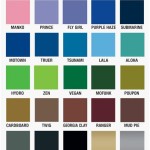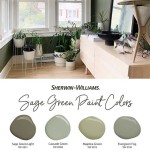How To Decide What Colors To Paint The Interior Of Your House
Choosing paint colors for the interior of a house can be a daunting task. The colors selected will impact the overall aesthetic feeling of the home and can significantly affect the mood and ambiance of each room. Careful consideration of various factors is crucial to making informed decisions that align with personal preferences, functionality, and the inherent characteristics of the space. This article provides a guide to navigating the process of selecting interior paint colors, focusing on key considerations and practical steps for achieving a harmonious and visually appealing result.
Consider the Existing Architectural Style and Natural Light
The architectural style of a house provides a foundational framework for color choices. A traditional home often lends itself to more classic and neutral palettes, while a modern or contemporary space may welcome bolder and more vibrant hues. It is essential to consider the existing trim, flooring, and any fixed elements that will remain in place. These features act as anchors and should complement the chosen paint colors.
Natural light plays a crucial role in how colors appear within a room. South-facing rooms tend to receive warm, bright light, which can enhance the vibrancy of colors. North-facing rooms, on the other hand, receive cooler, diffused light, which can make colors appear more muted. It is advisable to test paint swatches in the specific room at different times of the day to observe how the light affects the color's appearance. Colors that appear appealing in a brightly lit area may seem dull or washed out in a darker space.
In rooms with limited natural light, consider using lighter, reflective colors to maximize brightness and create a more open and airy atmosphere. Conversely, in rooms with abundant natural light, darker or more saturated colors can be used without making the space feel small or cramped. The interplay of light and color is a dynamic relationship that significantly impacts the overall perception of a room.
Analyze the Functionality and Desired Mood of Each Room
The purpose of each room should heavily influence the color selection. A bedroom, for example, often benefits from calming and relaxing colors, such as soft blues, greens, or neutrals. These colors promote tranquility and contribute to a restful environment. A living room, where social interaction and relaxation occur, may benefit from warmer, more inviting colors, such as earthy tones or muted yellows. The choice of color should align with the intended activities and desired atmosphere of the space.
Kitchens and dining rooms often encourage appetite and conversation. Warmer colors like reds, oranges, and yellows can stimulate both of these. However, it is important to use these colors judiciously, as excessive saturation can be overwhelming. Lighter variations or accent walls can provide a balance. Bathrooms, often smaller spaces, benefit from light and airy colors that create a sense of cleanliness and spaciousness. Blues, greens, and whites are popular choices for bathrooms.
Beyond the general purpose of a room, consider the specific activities that take place within it. A home office, for example, may benefit from colors that promote focus and productivity, such as blues, greens, or grays. A playroom for children might incorporate brighter, more playful colors, while a reading room might benefit from warm, inviting colors that encourage relaxation.
Develop a Color Palette and Consider Color Theory
Creating a cohesive color palette for the entire house is essential for achieving a harmonious and visually appealing flow. This palette should consist of a few core colors that are repeated throughout the house, along with accent colors that provide visual interest and variety. A good starting point is to choose a neutral color for the main living areas, such as hallways and living rooms, and then build upon this base with complementary colors in other rooms.
Understanding basic color theory can greatly assist in developing a balanced and aesthetically pleasing color palette. Complementary colors, which are opposite each other on the color wheel, create a dynamic and contrasting effect. Analogous colors, which are adjacent to each other on the color wheel, create a harmonious and soothing effect. Triadic colors, which are evenly spaced on the color wheel, offer a balanced and vibrant palette. Careful consideration of these relationships can help to create a visually interesting and cohesive design.
Consider the undertones of colors when developing a palette. Colors can have warm (red, orange, yellow) or cool (blue, green, purple) undertones. Mixing colors with conflicting undertones can create a jarring or discordant effect. It is generally advisable to maintain consistency in undertones within a room or throughout the entire house. For example, if choosing a gray paint, decide whether a warm gray with brown undertones or a cool gray with blue undertones is more suitable for the overall aesthetic.
When selecting a color palette, consider using a color wheel or online color palette tools to visualize different color combinations and explore various options. These tools can help to identify complementary, analogous, and triadic color schemes, and can provide inspiration for creating a balanced and harmonious palette. Experiment with different combinations and consider how the colors will interact with each other in different rooms and lighting conditions.
Sample Paint Colors and Assess in Different Lighting Conditions
Once a color palette has been developed, it is crucial to sample the chosen paint colors before committing to a large-scale painting project. Purchase small sample-size cans of paint and apply them to different areas of the room. Observe the colors at different times of the day and under different lighting conditions, including natural light, artificial light, and evening light.
Paint the samples on a large piece of poster board or directly onto the wall, ensuring that the samples are large enough to accurately represent the color. Avoid painting the samples directly next to existing colors, as this can influence the perception of the new color. Instead, allow some space between the sample and any existing colors to provide a more accurate assessment.
Pay attention to how the color interacts with the surrounding elements in the room, such as furniture, flooring, and window treatments. Consider how the color complements or clashes with these elements and make adjustments to the palette as necessary. It is also helpful to solicit feedback from others, such as family members or friends, to gain different perspectives on the chosen colors.
The process of sampling and assessing paint colors is an essential step in ensuring that the final result meets expectations. It allows for adjustments to be made before committing to a large-scale painting project, saving time, money, and potential disappointment. Take the time to carefully evaluate the colors in different lighting conditions and against the existing elements in the room to make informed decisions.
Consider the Sheen of the Paint
The sheen of the paint, also known as the paint finish, refers to the amount of light that the paint reflects. Different sheens offer different levels of durability, washability, and aesthetic appeal. The choice of sheen should be based on the function of the room and the desired level of maintenance.
Flat or matte paint has the lowest sheen and provides a smooth, non-reflective finish. It is ideal for hiding imperfections on walls and creating a soft, elegant look. However, flat paint is less durable and more difficult to clean than other sheens, making it less suitable for high-traffic areas or rooms that are prone to moisture.
Eggshell paint has a slightly higher sheen than flat paint and offers a more durable and washable finish. It is a good compromise between aesthetics and practicality, making it a popular choice for living rooms, bedrooms, and hallways. Eggshell paint provides a subtle sheen that adds a touch of elegance without being overly reflective.
Satin paint has a higher sheen than eggshell paint and offers excellent durability and washability. It is ideal for kitchens, bathrooms, and children's rooms, where frequent cleaning is required. Satin paint provides a smooth, slightly reflective finish that is easy to clean and resistant to stains.
Semi-gloss paint has a high sheen and offers the highest level of durability and washability. It is ideal for trim, doors, and cabinets, where resistance to wear and tear is essential. Semi-gloss paint provides a shiny, reflective finish that is easy to clean and resistant to scratches.
Gloss paint has the highest sheen and provides a very shiny, reflective finish. It is typically used for accent pieces or areas that require a dramatic effect. Gloss paint is very durable and easy to clean, but it can also highlight imperfections on walls.
When choosing a paint sheen, consider the specific needs of each room and the desired level of maintenance. Flat or matte paint is best for low-traffic areas where aesthetics are paramount, while satin or semi-gloss paint is best for high-traffic areas where durability and washability are essential. The choice of sheen can significantly impact the overall appearance and functionality of the painted surface.

How To Choose Interior Paint Colors For Your Home

Choosing The Perfect Interior Paint Color Artisan Builders

Tips For Choosing Paint Colors The Interior Of Your Home Florence Pressure Washing

How To Choose Paint Colors For Your Home Interior
:strip_icc()/cdn.cliqueinc.com__cache__posts__277032__how-to-pick-paint-colors-277032-1549477717179-image.700x0c-d1893d3eeff342bd9daf0a9d1d275e4b.jpg?strip=all)
How To Pick Paint Colors According An Expert
:strip_icc()/cdn.cliqueinc.com__cache__posts__277032__how-to-pick-paint-colors-277032-1549477716321-image.700x0c-355e170426eb47c7a70362985dc90dc2.jpg?strip=all)
How To Pick Paint Colors According An Expert

How To Choose An Interior Paint Color Shoreline Painting

Tips For Choosing Whole Home Paint Color Scheme

Choosing The Best Interior Paint Colors For Your Home In Fair Oaks Ranch

How To Choose Paint Colors For Your Home Interior
Related Posts








